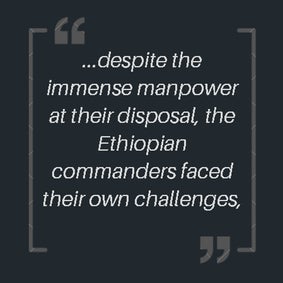End of the stalemate
On the 20 January 1936, as the Battle of Ganale Doria on the Southern Front of the conflict drew to a close, the Northern Front came under renewed focus. With the end of the Ethiopian Christmas Offensive hear found Ethiopian forces in a strong position - overlooking the Italian positions and constantly harassing them. The Italian leader, Mussolini, frustrated at the slow progress being made, pushed for a renewed Italian effort. The Italian commander, Badoglio, urged patience:
Ethiopian Forces
His caution was wise. Facing the Italians were a considerable force of Ethiopian soldiers – split into three groups:
- In the centre at Tembien was Ras Kassa with approximately 40,000 men and supported by Ras Seyum with an additional 30,000 troops.
- Ras Mulugeta Yeggazu and his 80,000 troops were located to the right of Kassa, at Amba Aradam.
- To the left of Kassa in the Shire province, was Ras Imru Haile Selassie with 40,000 men.

Ethiopian soldiers moving through the mountains. Northern Front.
World 1900 - 1950: Italo - Abyssinian War 1935 -1936 (vojna2historia.blogspot.com)
However, despite the immense manpower at their disposal, the Ethiopian commanders faced their own challenges, mainly based around Ethiopia's limited experience of involvement in military conflicts and the background of the Ras's themselves - having limited training and experience when it came to fighting a war against a modern military power.
It was one thing to lead your troops against a localised rebel uprising, but another to face off against a professional Italian army, equipped with artillery, armour and air support.
Imru's men lie in wait.
Sheba's Sons - Haile Selassie goes to Tokyo | Page 3 | alternatehistory.com
The Ethiopians were determined to stand their ground and it was felt Tembien was as good a place as any.
Some Ethiopian units were better trained and had access to relatively modern equipment.
Italian Forces
In response, the Italians could muster five army corps:
- The Italian II and IV Corps – facing Ras Imru at Shire.
- The Eritrean Corps were in the centre – facing Ras Kassa and Ras Seyoum’s forces at Tembien.
- The Italian I and III Corps were located at Amba Aradam – facing Ras Mulugeta Yeggazu’s forces.
Badoglio initially prioritised Mulugeta’s forces – the destruction or removal of his army from Amba Aradam would ensure the Italian advance on the Ethiopian capital was that much easier. But due to the increasing pressure from the Ethiopian forces at Tembien, the Italians were forced to confront them first. Badoglio reasoned that if they successfully defeated the Ethiopian forces in the centre at Tembien, Mulugeta’s forces at Amba Aradam would find themselves cut off.
Italian troops at Tembien.
The Eritreans advance
On 20 January, after closing the road to Tembien to prevent any reinforcements or supplies reaching Kassa and Seyoum, Badoglio launched his attack. Eritrean forces advanced in two columns – the 2d Eritrean division moving towards Ab’aro pass and the 2nd CC.NN. Division “28 Ottobre” advancing on Beles River. The Italian III Corps secured Nebri and Negada.
Pushing further on, 1500 Italian soldier, led by General Diamanti advanced on the Daran area but heavily outnumbered, were repulsed by Ethiopian forces. The Ethiopians then began to exert their own pressure, forcing the 2nd Eritrean Division to halt at Ab’aro Pass and pushing the 2nd CC.NN division back to Worsege Pass where it was encircled and besieged, the Ethiopians using their numerical superiority effectively to relentlessly attack the trapped Italians for three days.

Map detailing the positions of the Italian and Ethiopian forces.
In response, Badoglio pushed the 1st Eritrean Division into the Ab’aro pass to reinforce his forces and sent the 2ND Eritrean Division to relieve the besieged Italians at Worsege Pass. By the 22nd January, the encircled Italian forces were still holding out but low on water and ammunition and facing increasingly aggressive Ethiopian attacks.
With the situation looking increasingly perilous for his trapped soldiers, Badoglio even considered a risky withdrawal which would have involved all 70,000 soldiers, 14,000 animals and 300 artillery pieces retreating along a single road – all while being pursued and attacked by Ethiopian forces (who presumably would have noticed the Italians trying to escape and reacted accordingly).
Italian machine gunners at Tembien.
Fortunately for Badoglio, he never had to enact this plan as the trapped Italian forces continued to desperately hold on and were eventually relieved by Italian forces. However, it was the Italian Air Force that proved decisive - continually flying offensive sorties over the battle area and dropping Mustard Gas on the attacking Ethiopian forces. This helped slow and hamper the Ethiopian attacks with Ras Kassa himself acknowledging that his men could eventually no longer tolerate the continued assault from the air.
Painting of the battle, depicting the Italians effective use of air support.
Aftermath
By the 24 January, the battle had effectively ended. Although the Ethiopian forces had been forced to withdraw, they largely remained intact and still held the area around Tembien. However, they no longer presented a realistic threat to the Italian forces facing them in the centre – the Italian I and III corps. This now meant Badoglio could focus on the Ethiopian forces led by Ras Mulugeta who were embedded at Amba Aradam.
Although a strategic success for the Italians, the first battle of Tembien had failed to destroy the Ethiopian forces which ensured further battles lay ahead.
Contemporary Italian map showing the military situation after the First Battle of Tembien.
Sources:
Wikipedia
Barker, A. J., The Rape of Ethiopia 1936
Feodor Konovalov and the Italo-Ethiopian War – part II | THE ABYSSINIAN CRISIS (wordpress.com)
World 1900 - 1950: Italo - Abyssinian War 1935 -1936 (vojna2historia.blogspot.com)
Sheba's Sons - Haile Selassie goes to Tokyo | Page 3 | alternatehistory.com










